 This one must be defective. It hasn't made me want to smile at all. 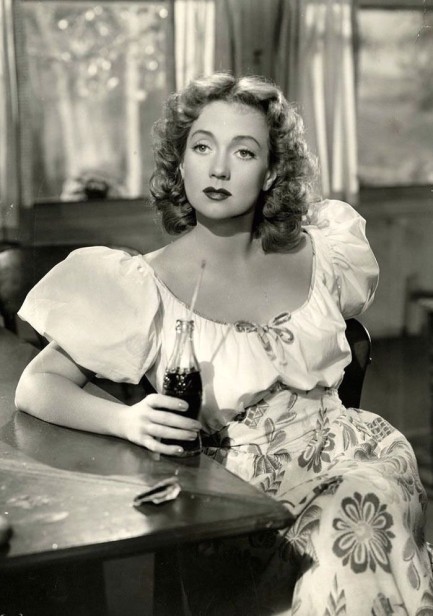
Coca Cola's advertising tagline—“Have a Coke and a smile”—is probably one of the most famous in corporate history, though it hadn't been thought of yet back when U.S. actress Ann Sothern posed with a Coke for this promo image made for her 1947 movie The Judge Steps Out. Back then the company's slogan was, “Coke knows no season.” Sothern knows no season either. She accumulated a hefty number of credits on radio, television, stage, and screen—more than one hundred, if we count correctly—including in The Blue Gardenia, Shadow on the Wall, and Super-Sleuth. We've shared a couple of promo images of her before, one of which was amusingly similar to today's. Have a look here. Sothern will be back.
 Look, I've found something! I bet this advances the plot! 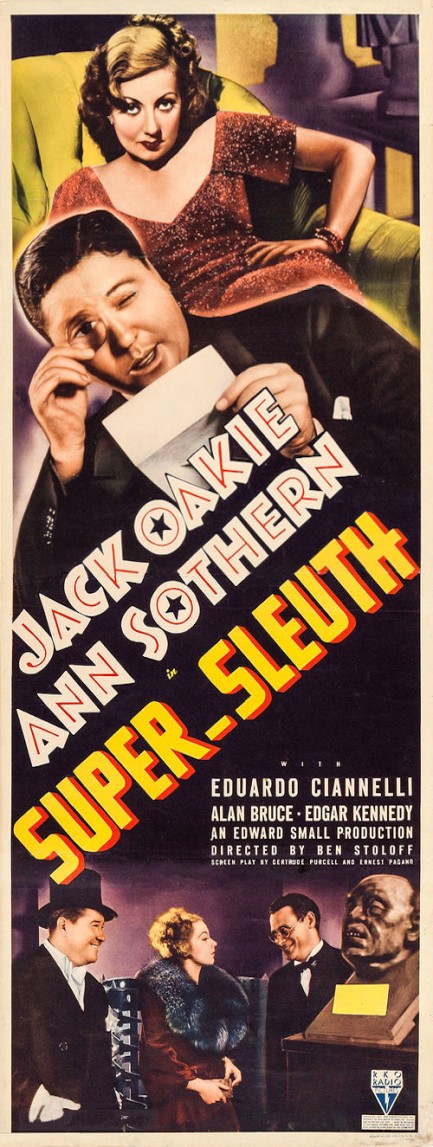
Here's another nice panel length poster for the 1937 mystery comedy Super-Sleuth. The term "door panel," which is a commonly used designation, is a bit deceptive. These are nowhere near the size of a door. The dimensions are twenty by sixty, or sometimes fourteen by thirty-six—in any case around three times taller than wide. The dimensions of this one aren't actually quite there. It's closer to two-point-five-to one. Close enough, as far as we're concerned. Anyway, we've been unearthing a lot of this style of promo lately, and we like them because the arrangement of visual elements and text are pleasing to our amateur eyes.
In the movie, an egotistical actor played by Jack Oakie, whose signature character is a sleuth, criticizes the LAPD and ends up in a press feud with them. He's been critical because he and other Hollywood stars have been receiving threatening letters from “the Poison Pen,” but the cops have no idea who's sending them. Oakie gets his chance to prove whether he can be a real life sleuth when there's a shooting on his movie set. While Super-Sleuth is billed as slapstick mystery, the mystery part is not delivered. There's only ever one true suspect. We suppose it's difficult to write in red herrings and twists when a film is 75 minutes long. Still, having the sinister and secretive weirdo be the murderer is a little too elementary.
Though many of the characters, including Oakie, are buffoons, there's also, it must be noted, a ridiculous black stereotype played by Willie Best, who sometimes acted under the moniker Sleep 'n' Eat. He's often reviled for his portrayals now, but in a 1934 interview he said, “What's an actor going to do? Either you do it or get out.” It's the dilemma of all actors—do your level best with what you're given or end up on the do-not-hire list. Super-Sleuth doesn't give its actors a lot to work with, but Oakie, Best, the beautiful Ann Sothern and the rest put their all into it and the result is a passable slapstick (non) mystery with a handful of genuine laughs. It premiered in the U.S. today in 1937.
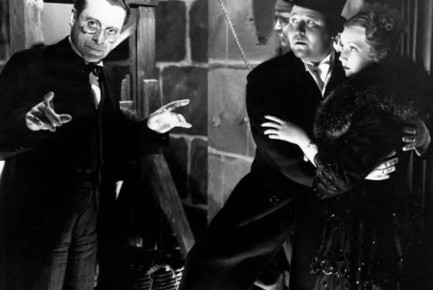 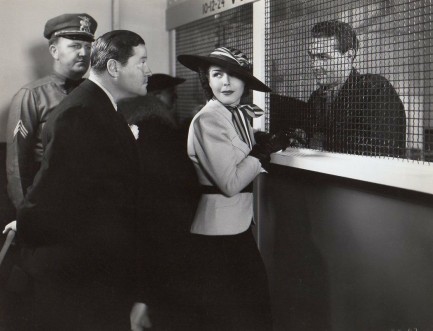 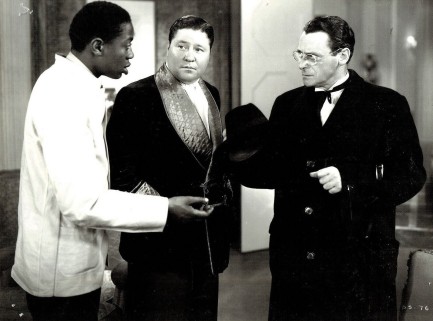 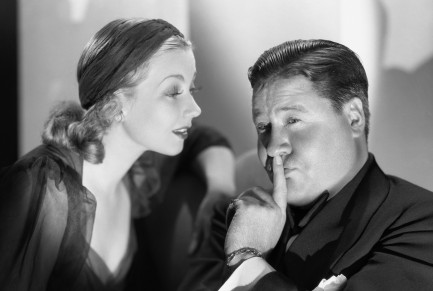 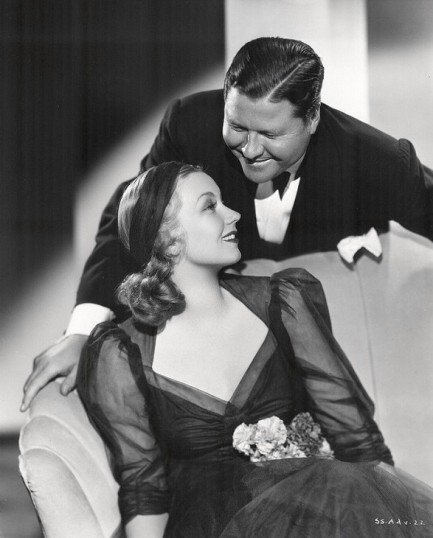 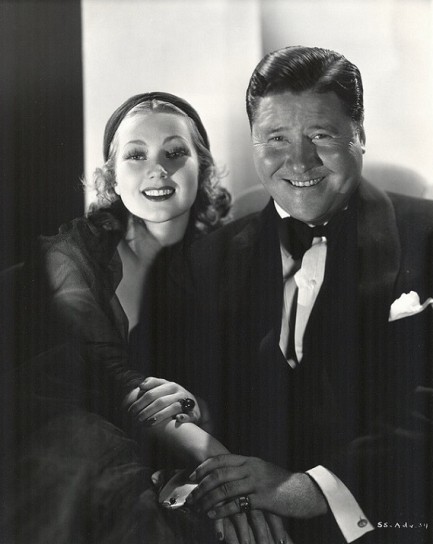
 Bartender, give me another. And put a shot of optimism in this one. 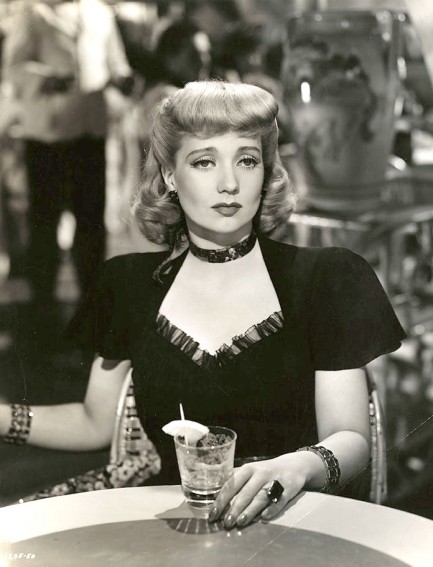
Above: a promo shot of Ann Sothern made when she was filming the interestingly named 1942 flick Panama Hattie, which was based on a Broadway production of the same name. She plays a saloon keeper, which is sort of pulp, but it's a musical romance, which ain't pulp. That's probably why she looks so sad.
 Who's afraid of him? Nobody anymore. 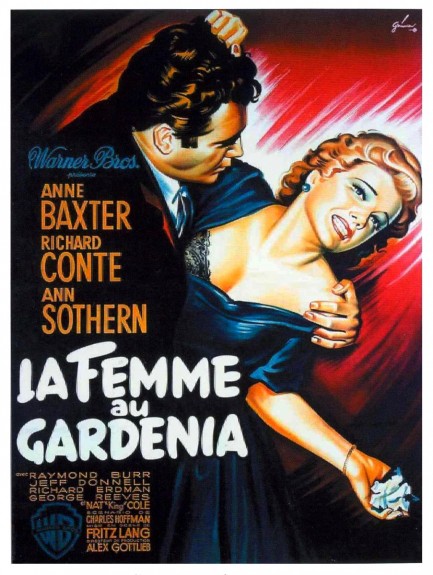
Isn't this a great poster? It was painted for La femme au gardénia, better known as The Blue Gardenia. Every once in a while you come across an old movie that's so ahead of its time you can't believe what you're seeing. This one is about a woman's response to sexual coercion, and law enforcement's reaction to the aftermath. Basically, Anne Baxter, who's five-three and a buck twenty, ends up in the apartment of Raymond Burr, who's six feet and goes at least 230. Burr plies Baxter with booze, and when he later tries to get her horizontal a struggle ensues and he ends up dead. Baxter escapes the apartment, and thanks to the arrival of a very efficient cleaning lady nearly all the evidence of her presence is accidentally erased the next morning before Burr's body is discovered.
So Baxter's scot-free? Well, not quite. There's that whole guilt, edginess, and fear thing, which her roommates notice. And there are a few bits of evidence, which lead to police drawing ever closer. All these are good plot moves. Lacking an identity for the killer, the press begins calling her—the bit of evidence that exists indicates it's a her—the Blue Gardenia, which is a clear Black Dahlia echo. We liked that. And we also liked that, at this point, the film was a thriller built wholly around consent and power. But this was the 1950s. Of course they weren't trying to impart that lesson. What were we thinking? Instead, an ending so pat that it almost ruins the movie comes blundering over the horizon. Is it wrong to suggest watching the first 75 minutes of this and turning it off?
Okay, the movie isn't completely trashed by the ending. It's just that we thought we had something daring on hand, and in reality it's a decent-not-great semi-noir from Fritz Lang that flirts with feminism but decides not to close the deal. However, the story was derived from a novella by author and playwright Vera Caspary, and we can't help wondering if the suits overruled her on a different ending. Probably not, but we'll have to dig that tale up and read it anyway. Regardless, we think the movie is worth watching just for Anne Baxter's bravura performance. And we love the platinum poodle cut she sports too. Plus there's Nat King Cole as, presumably, himself. The Blue Gardenia opened in the U.S. in 1953, and premiered in France today in 1954 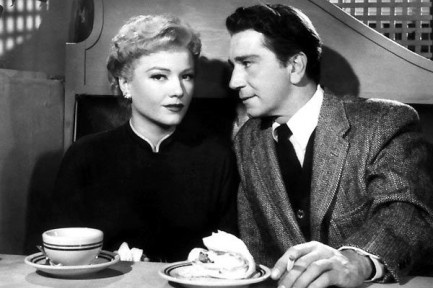 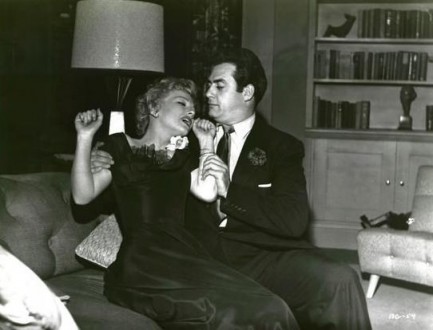 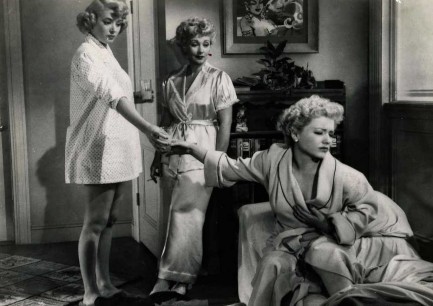 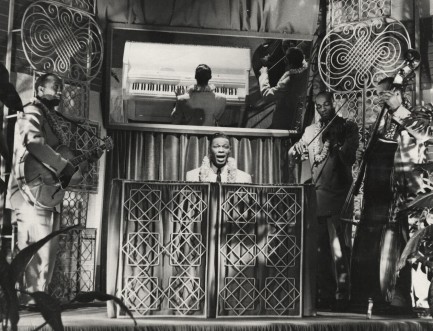 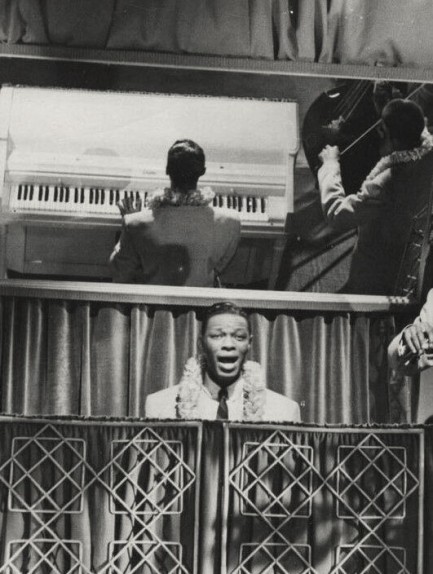 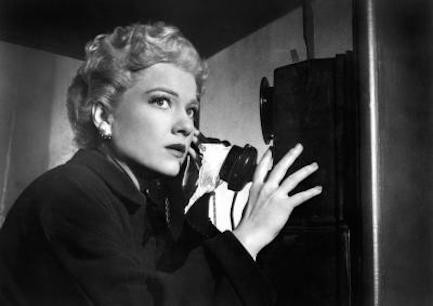 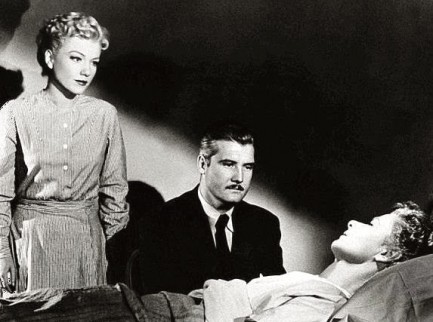 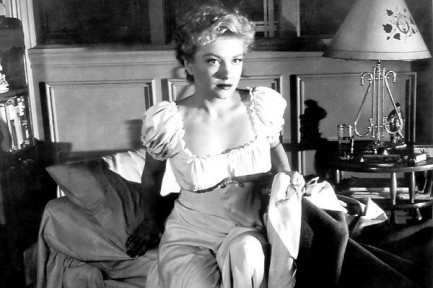
 Invitation to a dark place. 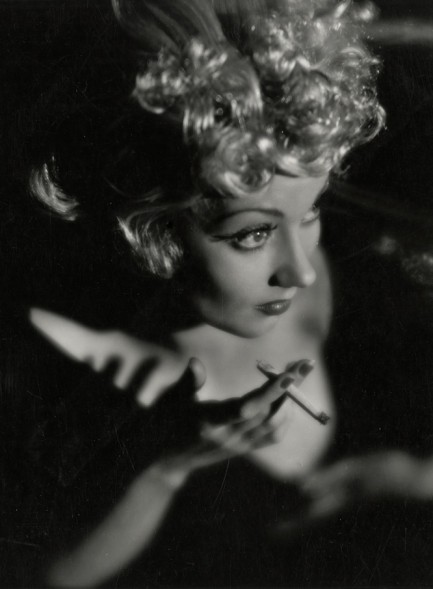
Above, American actress Ann Sothern, who first appeared onscreen in 1927 and last in 1987, along the way starring in Fast and Furious, The Blue Gardenia, the comedy Maisie and its eight sequels, and dozens of other films, as wells as Broadway plays and television shows. This amazing shot, with Sothern’s luminous, somewhat expectant eyes peering out from shadow, is from 1934.
 To get to the top you sometimes have to climb over someone else. 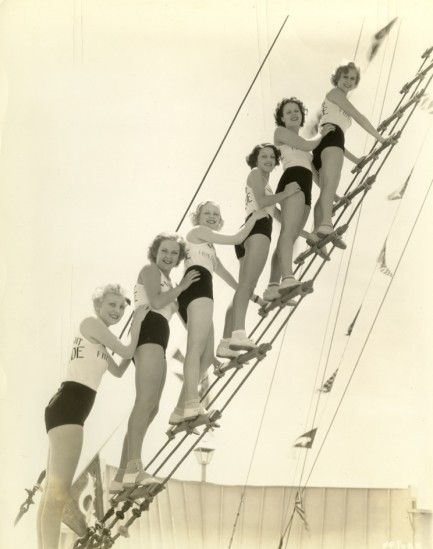
This publicity photo from Warner Bros. shows six members of the studio’s beauty chorus posing on a ladder that was part of a pirate ship being used in the 1933 Busby Berkeley musical Footlight Parade. This is not the first time this movie has been mentioned on Pulp Intl. We shared an excellent magazine cover related to it last year. Among the chorus girls who appeared in the film were nineteen-year-old Dorothy Lamour and twenty-two-year-old Ann Sothern, both just beginning their careers. The women above are not identified, but if we had to guess we’d say Lamour could be third from the top.
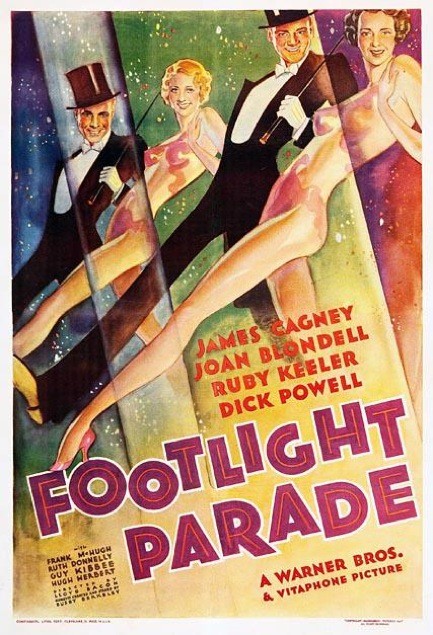
 The magazine that whispered rape. 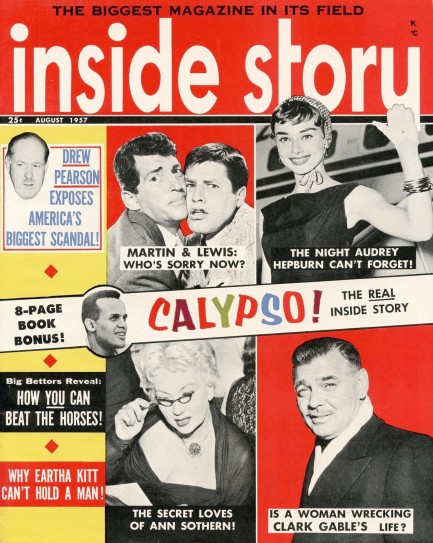
Inside Story of August 1957 offers up stories on Elsa Martinelli, Ann Sothern, Clark Gable and others, but the subhead reading “The Night Audrey Hepburn Can’t Forget” is irresistible. So what happened on the night in question? Nothing fun, unfortunately. Fully expecting to read about some wild party or drunken escapade, journo Gwen Ferguson instead tells us that in 1942, when Hepburn was a Dutch teen named Audrey Kathleen Ruston, she was “brutally kidnapped and subjected to terrible indignities” by a Nazi soldier. As is typical for mid-century tabloids, this claim comes not from direct interviews, but rather from a fly-on-the-wall third person account. In this case, the magazine claims she confessed what happened to prospective husband Mel Ferrer, pictured next to her below, because she wanted him to have a chance to rescind his marriage proposal. The implication is clear—“indignities” is a euphemism for rape. Or else why would Ferguson suggest Ferrer might turn tail and run? In light of all the discussion about rape lately, it’s instructive to go back in time and read such an incendiary insinuation presented so casually in a national magazine, probably by some pseudonymous male editor, if tradition holds true. Looking for corroboration, we found only stories about Hepburn living in constant fear of being kidnapped, but that’s all. In no place we looked did we find any reference to her actually being taken, let alone violated. So we don’t know where Inside Story got its information. That being the case, we have to call bullshit. Inside Story goes on to wrap its dubious claim in the truth by telling readers how Hepburn’s uncle was executed by Nazis—true; how she gave secret ballet performances to generate funds for the Dutch resistance—true; and how she used tulip bulbs to make the flour needed for cakes and biscuits, but went through the war malnourished and underweight—true and true. As for the other claim—if untrue, it’s pretty low, and if true, it’s both low and irresponsible. Even by the standards of mid-century scandal sheets. 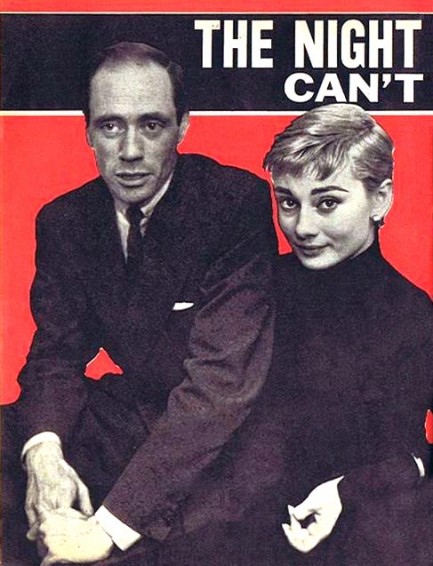 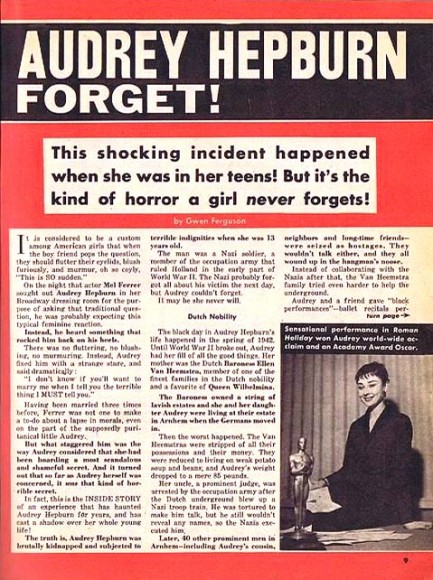
|
 |

The headlines that mattered yesteryear.
2003—Hope Dies
Film legend Bob Hope dies of pneumonia two months after celebrating his 100th birthday. 1945—Churchill Given the Sack
In spite of admiring Winston Churchill as a great wartime leader, Britons elect
Clement Attlee the nation's new prime minister in a sweeping victory for the Labour Party over the Conservatives. 1952—Evita Peron Dies
Eva Duarte de Peron, aka Evita, wife of the president of the Argentine Republic, dies from cancer at age 33. Evita had brought the working classes into a position of political power never witnessed before, but was hated by the nation's powerful military class. She is lain to rest in Milan, Italy in a secret grave under a nun's name, but is eventually returned to Argentina for reburial beside her husband in 1974. 1943—Mussolini Calls It Quits
Italian dictator Benito Mussolini steps down as head of the armed forces and the government. It soon becomes clear that Il Duce did not relinquish power voluntarily, but was forced to resign after former Fascist colleagues turned against him. He is later installed by Germany as leader of the Italian Social Republic in the north of the country, but is killed by partisans in 1945.
|

|
|

It's easy. We have an uploader that makes it a snap. Use it to submit your art, text, header, and subhead. Your post can be funny, serious, or anything in between, as long as it's vintage pulp. You'll get a byline and experience the fleeting pride of free authorship. We'll edit your post for typos, but the rest is up to you. Click here to give us your best shot.

|
|



































































































